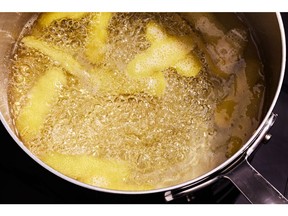Through plague, scurvy and heat, lemonade has always been there for us

Article content
Reviews and recommendations are unbiased and products are independently selected. Postmedia may earn an affiliate commission from purchases made through links on this page.
When life hands you lemons, it’s not necessarily trying to destroy whatever scant fibres of sanity you have left. On the contrary, lemons may very well be the thing that ends up saving you! On some level, lemons have always been looking out for us, even if we insist on making them the sourpuss in our sayings.
Originating in the once-borderless lands of Asia, the earliest lemons were far too bitter to eat, but humans established plenty of medical uses for every part, including rind and root. Lemons balanced vata and qi — a.k.a. vital life energies — all while looking gorgeous. As curative as it was, the tree was prized primarily as an ornament, and as civilizations expanded, the lemon, on the strength of its good looks, made its way westward to Ancient Rome. It also helped that beneath the sweltering Mediterranean sun, lemons perfumed the air with a glorious aroma that was intoxicating to humans … and repulsive to flies and mosquitoes.
By the Middle Ages, lemons had been selectively bred until they were sour, and Islamic physicians had unlocked even more of the fruit’s curative potential. Elixirs of honey-sweetened lemon water – prescription-strength lemonade – were used to treat ailments such as stomach worms. In the 10th century, Italy’s famed medical school in Salerno discovered that citrus could be the solution to the dreaded nautical affliction scurvy. It would take another eight centuries, and the lives of millions of sailors, before the navies of Northern Europe discovered the same.

It’s not surprising that something so tasty as lemonade eventually made its way from healthful tonic to casual beverage, and became the trendiest drink in 17th-century Paris. Thousands of lemonadiers roamed the city streets with large canisters, quenching Parisians’ thirst and, one theory has it, possibly saving them from a plague outbreak in the process.
A resurgence of the Black Death had been steamrolling its way throughout Europe, wiping out town after town, as it made its way toward Paris. Yet somehow, the city was largely spared! Many believed it to be a miracle, for what else could deter such an unknowable horror? It would be another 200 years before the advent of germ theory, or the discovery that plague wasn’t caused by evil spirits but spread by the fleas that tormented rats.
No one had any reason to consider that what may have saved the city was its garbage-filled gutters, or the incalculable number of discarded rinds left by the legions of lemonadiers. They didn’t know that the oil in lemon rinds happens to be a powerful insecticide that kills fleas. All they knew is that someone – or something – was looking out for Paris, keeping its citizens safe from plague, and its rats free from itchiness.
In the United States, lemonade first gained popularity in powdered form; whipped up by pharmacists using sugar and lemon oil, it was a must for pioneers venturing into wild frontiers, where it helped mask the taste of questionable water sources along the way. When temperance movements started gaining steam in the 19th century, teetotalers held up lemonade as the refreshing alternative to alcohol – the first “mocktail” for the emerging sober set.
Since it’s mostly water and sugar, lemonade doesn’t actually derive many “healthy” benefits from the lemon’s chemistry, but plenty from its flavor. In that spirit, my recipe for the classic drink stars by infusing sugar syrup with lemon peels, before the juice even enters the picture.
During the 1918 flu pandemic, a collective of California citrus growers (known as Sunkist) decided that the refreshing taste of lemon could spur the infirm to drink more fluids. While doctors understood it wasn’t a cure, they knew hydration helped patients survive, so lemon was medicine. Sunkist ran newspaper ads advising the public to “avoid crowds, take adequate exercise, get plenty of sleep, and drink one or two glasses of hot lemonade daily.” (The flu must have found iced lemonade just too refreshing.)
While lemonade might not be medicine, there’s still science behind its ability to quench your thirst on the hottest of days. Lemonade, like all sour liquids, stimulates salivation. When you’re dehydrated, your mouth goes dry, and acidic drinks don’t just replenish your body’s water – they keep your mouth feeling good. The better something tastes and makes you feel, the more you’ll drink. Lemons have always wanted good things for you, and still do.
Classic Lemonade
Servings: 6-8 (makes about 6 cups)
Total time: 20 mins, plus steeping and refrigeration time
For a lemonade that’s bursting with bright, puckery flavor, strips of lemon peel are simmered in simple syrup to extract their fragrant oils before mixing the syrup with water and fresh lemon juice. Give it a taste before serving; if you’d like it to be less tart, add more water to dilute.
Make ahead: The lemonade needs to be prepared and completely chilled for at least 2 hours before serving.
Storage: Refrigerate for up to 1 week.
INGREDIENTS
6 large lemons, preferably organic and unwaxed (about 2 pounds total)
5 cups water, divided
1 1/4 cups granulated sugar
1/8 teaspoon fine salt
Ice
DIRECTIONS
Use a vegetable peeler to remove the peel from 3 of the lemons in long strips. (If there is a lot of white pith on the peel, remove it with a sharp paring knife but don’t worry about getting all of it.) In a small (1- to 2-quart) saucepan over medium-high heat, combine 1 1/2 cups of the water with the sugar, peel strips and salt, and bring to a boil, stirring to dissolve the sugar completely. Turn off the heat and let the syrup steep for 15 minutes.
Meanwhile, halve and juice the lemons. You should have about 1 cup. Transfer the juice to a pitcher, add the remaining 3 1/2 cups of water, and stir to combine.
After the syrup is done steeping, use a fine-mesh sieve to strain the syrup into the pitcher and stir to combine. Transfer the softened lemon peels to a wire rack set over a large sheet pan, and let cool and firm up. Transfer the lemonade to the refrigerator and chill until completely cold, 2 to 3 hours.
When ready to serve, fill glasses with ice, add the lemonade and garnish with a candied lemon peel, if desired.
Substitutions:
Lemons >> limes.
Nutritional Facts per serving (3/4 cup), based on 8 | Calories: 123; Fat: 0 g; Saturated Fat: 0g; Carbohydrates:32 g; Sodium: 36 mg; Cholesterol: 0 mg; Protein: 0 g; Fiber: 0 g; Sugar: 31 g
This analysis is an estimate based on available ingredients and this preparation. It should not substitute for a dietitian’s or nutritionist’s advice.











Postmedia is committed to maintaining a lively but civil forum for discussion. Please keep comments relevant and respectful. Comments may take up to an hour to appear on the site. You will receive an email if there is a reply to your comment, an update to a thread you follow or if a user you follow comments. Visit our Community Guidelines for more information.